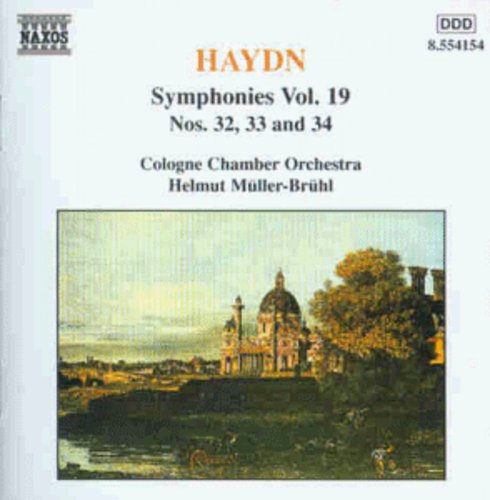Show results for
Deals
- 4K Ultra HD Sale
- Action Sale
- Alternative Rock Sale
- Anime sale
- Award Winners Sale
- Bear Family Sale
- Blu ray Sale
- Blues on Sale
- British Sale
- Classical Music Sale
- Comedy Music Sale
- Comedy Sale
- Country Sale
- Criterion Sale
- Drama Sale
- Electronic Music sale
- Golden Age of Hollywood sale
- Horror Sci fi Sale
- Kids and Family Sale
- Metal Sale
- Music Video Sale
- Musicals on Sale
- Mystery Sale
- Naxos Label Sale
- Page to Screen Sale
- Paramount Sale
- PBS on Sale
- Rap and Hip Hop Sale
- Reggae Sale
- Rock
- Rock and Pop Sale
- Rock Legends
- Soul Music Sale
- TV Sale
- Vinyl on Sale
- War Films and Westerns on Sale

Symphonies 19
- Format: CD
- Release Date: 5/26/1998

Symphonies 19
- Format: CD
- Release Date: 5/26/1998
- Orchestras: Cologne Chamber Orchestra
- Label: Naxos
- UPC: 636943415429
- Item #: NAX341542
- Genre: Classical
- Release Date: 5/26/1998

Product Notes
Whether Haydn was the father of the symphony is a question best left to musical genealogists. His career, however, spanned the period during which the classical symphony developed as the principal orchestral form. He himself certainly played a major part in this development, from his first symphony some time before 1759 to his final series of symphonies written for the greater resources of London in 1794 and 1795. The London symphonies were preceded by similar works for Paris and a much larger body of compositions of more modest scoring for the orchestra at Esterháza and at Eisenstadt, many of the last calling for a keyboard continuo, at least with the relatively smaller number of string players available.
It seems that Symphony No. 32 and Symphony No. 33 may be dated to 1760, or thereabouts, to a period when Haydn was employed in Lukavec by Count von Morzin in a musical establishment that was soon to be disbanded. The first of these is a festive work, in the appropriate key of C major and using trumpets and drums. It is otherwise scored for the necessary strings, with pairs of oboes and horns, the latter presumably in C alto, and a bassoon doubling the cellos and double bass. The first movement opens in appropriate style, with a bright, celebratory first subject, leading to a second subject that is at first in G minor. There is a central development, exploring this material and leading to the inevitable recapitulation, the return of the original key and first subject, with the second subject, which has had it's turn already in the development, now omitted. The whole orchestra continues with the Minuet, with it's C minor Trio for strings alone. This is followed by the slow movement, marked Adagio ma non troppo, an F major movement scored only for strings. Wind instruments return for the final Presto, in a forceful and triumphant 3/8, a briefer version of the tripartite form that had marked the first movement. Symphony No. 33, in C major and similarly scored, also belongs to Haydn's period of employment under Count von Morzin. The celebratory mood of the work echoes that of it's immediate numerical predecessor, opening with a movement in 3/4, marked Vivace. There is a more varied and extended second subject, in G major, the key in which the development begins, with it's reminiscence of the first theme and inventive writing in the music that follows, with an element of surprise in an anticipation of the recapitulation, before the proper return of the first subject and material of the initial exposition. The second movement, marked Andante, is in C minor and scored for strings only, for a time using a sparer two-part texture. The Minuet, for the whole orchestra, frames a softer Trio in F major, scored for strings. The wind instruments return for the final Allegro, now in a fuller tripartite sonata-form. Symphony No. 34 in D minor belongs to a slightly later period, probably 1765, when Haydn was in Eisenstadt in the service of Prince Nikolaus Esterházy. The work, perhaps the earliest of Haydn's symphonies to be in a minor key, is scored for two oboes, bassoon, two horns in D and strings, and follows the pattern of a church sonata with an opening slow movement, here marked Adagio. This movement, imbued with melancholy, is followed by a cheerful D major Allegro, with wide spacing in the first subject for first violins and a second subject that brings prominence to the oboes, material much abbreviated in it's final appearance in the recapitulation. The same key continues in the Minuet, marked Moderato, and Trio, the latter allowing the wind instruments to assume greater importance. Triplet rhythms mark the thematic material that introduces the final Presto assai, with it's central passage in the tonic minor key.
